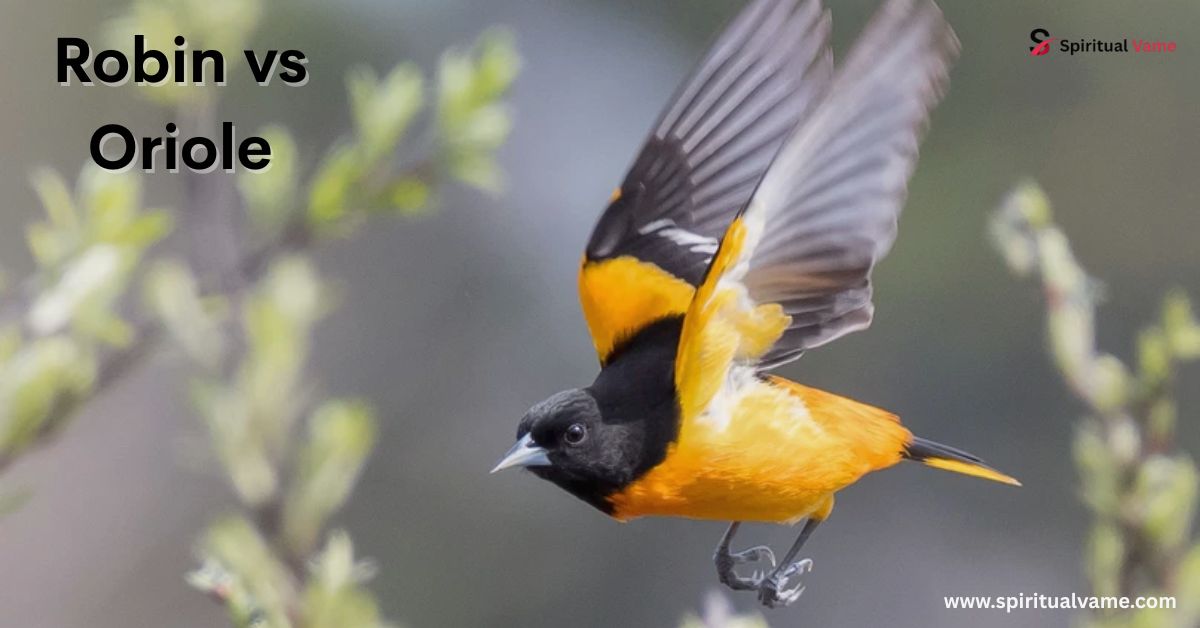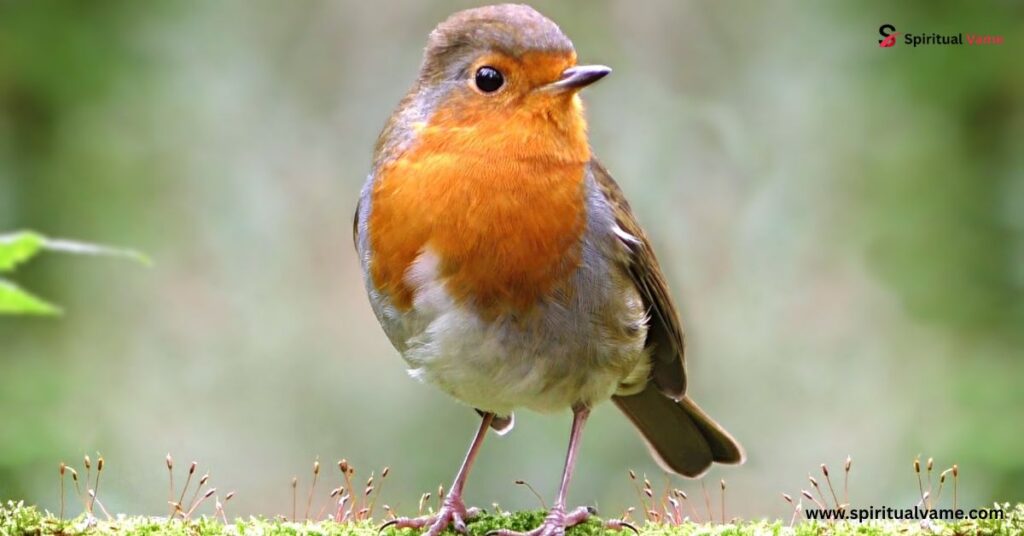
If you’ve ever spotted a bright orange bird hopping around your lawn or flitting through treetops, you might have wondered if it was a robin or an oriole. These two New World passerines are commonly found across the United States, yet they belong to completely different avian families. The American robin (Turdus migratorius) is part of the Turdidae family and closely related to thrushes, while the Baltimore oriole (Icterus galbula) is a member of the Oriolidae family, which includes several striking blackbird species.
Both birds are known for their colorful plumage and beautiful songs, but their differences go far beyond just looks. In this guide, we’ll walk you through everything you need to know about robin vs oriole, including their scientific classification, behaviors, and even how their names inspired a pair of stylish headphones. You’ll never confuse these two again.
Comparing American Robin vs Oriole

When comparing robins and orioles, it helps to first look at their lifestyles. Robins are early risers—you’ll often see them tugging worms from the ground in your backyard. Orioles, on the other hand, prefer higher elevations and are more likely to be spotted sipping nectar from flowers or feasting on fruit. While both are songbirds and part of the passerine order, their behaviors and feeding styles set them apart.
Robins are more grounded, literally and behaviorally. They nest in shrubs or trees but hunt mostly on the ground. Orioles are more elusive and prefer nesting high up in trees, where they weave beautiful hanging nests. Both birds sing to mark their territory and attract mates, but their tunes and performances are quite different in tone and structure.
8 Key Differences Between an American Robin and Oriole
The robin vs oriole debate is best understood by looking at their eight biggest differences. First is size: robins are larger and more rounded, while orioles are smaller with slender builds. Second is their color. Robins have red-orange bellies and gray-brown backs, while orioles dazzle with bright orange and black feathers, making them one of the most vibrant blackbirds in the New World avifauna.
Then there’s song and flight. Robins have a more repetitive, whistled tune; orioles produce fluty, almost tropical melodies. Their diets also differ—robins focus on insects and worms, orioles enjoy fruit, nectar, and the occasional insect. Add in their nesting styles, migratory patterns, and average lifespans, and you start to see just how distinct they really are.
American Robin vs Oriole| Scientific Classification
From a taxonomy point of view, robins and orioles aren’t close at all. The American robin, classified as Turdus migratorius, falls under the Turdidae family, the same as thrushes. Its genus Turdus includes birds from both the Old World and New World. Meanwhile, the Baltimore oriole, known scientifically as Icterus galbula, is part of the Oriolidae family, which consists of colorful perching birds often found in tropical regions.
Both birds are passerines, meaning they belong to the order Passeriformes, which includes more than half of all known bird species. Though they’re both songbirds, their evolutionary paths diverged long ago. The robin’s classification places it closer to Eurasian blackbirds, while the oriole is more closely related to New World blackbirds, grackles, and meadowlarks.
American Robin vs Oriole| Size and Shape

Physically, robins appear more robust. They have a thick body, strong legs, and a rounded belly that gives them a “puffed-up” look, especially when they’re fluffed up in cold weather. Their stance is upright and confident, and their powerful beaks are made for pulling worms from soil.
Orioles, by contrast, are slimmer, more agile, and have a longer, more pointed beak ideal for piercing fruit and drinking nectar. They seem built for speed and elegance. Their sleek frames help them dart quickly through branches, especially during mating season when they show off for potential mates.
American Robin vs Oriole| Colors and Variations
The plumage of both birds is their most striking feature, but in very different ways. Robins feature a warm reddish-orange breast, a yellow beak, and grayish-brown upperparts. They’re easy to spot in grassy areas or suburban gardens and have a muted but classic appearance.
Orioles are true showstoppers. Males sport brilliant orange underparts contrasted by jet-black heads, wings, and backs. Females are paler, with yellow-orange feathers and grayish backs. The oriole’s coloring is especially vivid during spring and early summer, when ornithologists often note their feathers are at their brightest.
American Robin vs Oriole| Distribution and Habitat
Robins are everywhere. They can be found in nearly every part of the United States, from Alaska to Florida. They thrive in suburban yards, city parks, forests, and even golf courses. You’ll often see them hopping on lawns, searching for worms, especially after a good rain.
Orioles are a bit more selective. They prefer open woodlands, river edges, and orchards. They are most commonly found in the Eastern and Central U.S., especially during spring and summer when they migrate up from Central and South America. Their strong migratory instinct makes them seasonal guests in many states.
American Robin vs Oriole| Flights and Songs
Both birds fly with grace, but robins have a more direct and slower flight. You’ll often see them gliding low to the ground in steady arcs. Their songs are short and whistled, often heard at dawn as one of the first signs of morning.
Orioles, however, have a more acrobatic flight pattern. They flit between treetops with fast wingbeats and can hover momentarily. Their songs are fluid, flute-like, and complex—far more musical than the robin’s simpler tune. Birdsong enthusiasts often admire the oriole’s call for its richness and variety.
American Robin vs Oriole| Clutch Size
When it comes to reproduction, robins lay 3 to 5 eggs per clutch and often produce multiple clutches in a single season. Their nests are cup-shaped and made from mud and grass, built low in trees or shrubs.
Orioles lay 3 to 7 eggs, but typically have just one clutch per season. Their nests are a marvel—woven sacks that hang from tree branches like ornaments. These pendulous nests keep the eggs safe from ground predators and showcase the oriole’s incredible weaving skills.
American Robin vs Oriole| Mating Behavior
Robin courtship involves ground displays—males puff their chests, hop around, and feed the females. They tend to form temporary pairs just for the breeding season, though some may stay together longer depending on environmental stability.
Orioles are flashier in their approach. Males perform aerial shows, flutter their wings, and sing elaborate songs to attract a mate. Once paired, they are typically monogamous for the season, and both partners are involved in feeding and protecting their young.
American Robin vs Oriole| Lifespan

A robin’s lifespan averages around 2–6 years in the wild, though some may live longer in protected areas. They’re often at risk from predators, cars, and harsh winters.
Orioles tend to live longer, averaging 6–12 years. Their high nesting spots and migratory lifestyle help them avoid some common dangers. Still, they face threats like habitat loss and window collisions during migration.
What Is the Difference Between an Oriole & a Robin?
The difference between a robin and an oriole goes far beyond color. It’s about size, song, behavior, and even scientific classification. Robins are thrushes, grounded and hearty, while orioles are blackbirds, sleek and musical. Understanding these distinctions helps bird lovers appreciate each species for its unique charm.
Size and Shape
Robins are bulkier and built for ground foraging, while orioles are lighter and built for agility. If you see a plump bird hopping on your lawn, it’s likely a robin. A slender orange flash among the trees? That’s probably an oriole.
Colors and Variations
While both birds share orange tones, the robin’s is more muted and restricted to the belly. The oriole, however, wears its orange proudly across its chest and sides, offset by deep black feathers. It’s a much more contrasting and tropical look.
Feeding and Habitats
Robins hunt worms, insects, and berries, often in low open areas. Orioles feed higher up, preferring nectar, citrus fruits, and flower-dwelling bugs. Their habitat preferences reflect these diets—robins on the ground, orioles in the trees.
Flights and Songs
Robin songs are familiar, repetitive, and nostalgic. Orioles offer a more melodic, rolling tune. Their flight paths echo these traits: robins are predictable, orioles are dynamic.
Sivga Oriole vs Robin SV021 Comparison Review
Let’s switch gears. These Sivga headphones, named after our two birds, mirror their feathered inspirations. The Sivga Robin SV021 offers warm, grounded tones—much like the bird. The Sivga Oriole, on the other hand, delivers a brighter, more vivid soundstage.
Sivga Oriole vs Robin SV021 Comparison Review
Build quality is excellent in both models. But the Oriole leans toward modern elegance, while the Robin has a classic wooden design. The sound profiles differ too—Robin favors mids, while Oriole excels in clarity.
Look and Feel
The Robin has a sturdy, retro look with smooth wood grain. The Oriole feels lighter, more polished. Comfort is great on both, but the Oriole’s slimmer design may suit smaller heads better.
Design
Robin offers a vintage vibe. Oriole has a sleek, urban finish. Both are foldable, portable, and stylish, with minimal branding.
Soundstage
Robin provides warmth and depth, great for relaxed listening. Oriole spreads sound more widely, ideal for live recordings or ambient music.
Conclusion
In the end, the robin vs oriole comparison shows just how different these birds really are. From their colors and songs to their size and habitats, each bird brings something special. The robin vs oriole debate isn’t just about looks—it’s about behavior, diet, and where they live. Robins are ground birds; orioles prefer trees. Robins eat worms; orioles love fruit and nectar.
So, when you’re out birdwatching, knowing the difference matters. The robin vs oriole contrast is a fun way to learn more about nature. Whether it’s a backyard sighting or a forest walk, the robin vs oriole story adds color, sound, and joy to your bird watching experience.



